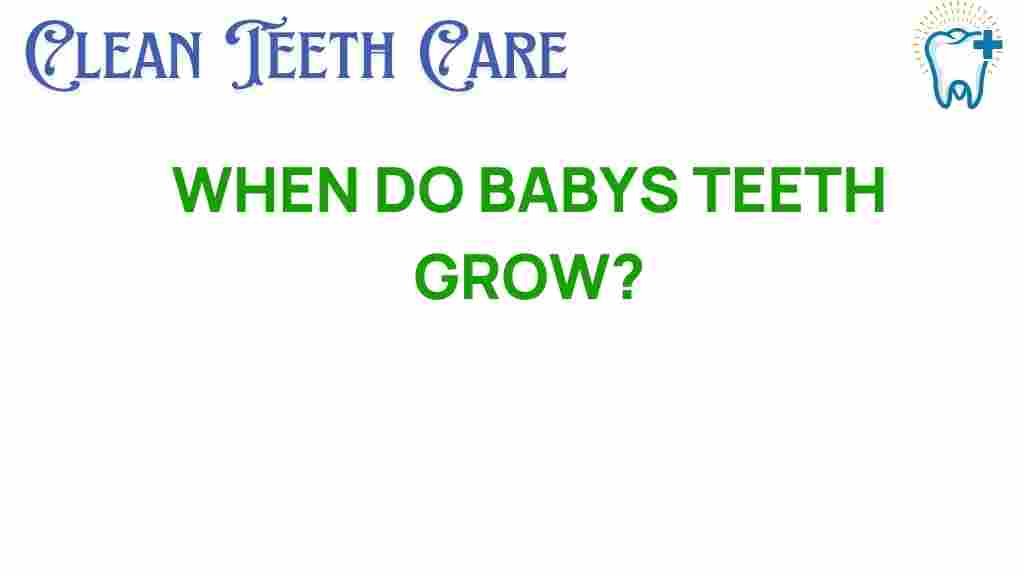The Surprising Timeline of Baby’s Teeth: When Do They Really Erupt?
Every parent eagerly anticipates the moment their baby’s first tooth breaks through the gums. This milestone not only signifies a major development in their infant’s growth but also opens the door to new challenges and responsibilities regarding oral health. Understanding the teething schedule and what to expect can help you navigate this period with ease. In this comprehensive guide, we will delve into the timeline of baby teeth eruption, explore key milestones in infant development, and provide essential tips for dental care.
Understanding Baby Teeth
Baby teeth, also known as primary teeth or deciduous teeth, are crucial for your child’s development. These teeth not only aid in eating and speaking but also play a vital role in forming the foundation for future adult teeth. Typically, babies have a total of 20 primary teeth, which begin to emerge around the age of six months.
The Teething Schedule: When to Expect Baby Teeth
The teething schedule can vary significantly from one infant to another. However, there are general timelines that most babies follow when it comes to tooth eruption:
- Central Incisors: 6 to 10 months
- Lateral Incisors: 9 to 13 months
- First Molars: 13 to 19 months
- Canines (Cuspids): 16 to 22 months
- Second Molars: 25 to 33 months
By the time your child reaches three years of age, they should have a complete set of 20 baby teeth. Understanding this timeline will help you monitor your child’s oral health and prepare for each stage of teething.
Teething Symptoms: What to Look For
As your baby’s teeth begin to erupt, you may notice several symptoms that indicate they are experiencing teething pain. Common signs include:
- Increased drooling
- Chewing on objects or fingers
- Irritability or fussiness
- Swollen or sensitive gums
- Changes in sleep patterns
Understanding these symptoms can help you provide appropriate comfort and care for your teething baby.
Tips for Easing Teething Discomfort
While teething is a natural process, it can be uncomfortable for your little one. Here are some effective tips to help ease their discomfort:
- Teething Rings: Provide a chilled teething ring for your baby to chew on. The cold can help numb the gums.
- Massage Gums: Gently rub your baby’s gums with a clean finger to soothe pain.
- Cold Foods: If your baby is eating solids, offer cold foods like yogurt or applesauce.
- Pain Relief: Consult your pediatrician about appropriate pain relief options, including acetaminophen or teething gels.
These methods can help alleviate some of the discomfort associated with teething, making the process a bit easier for both you and your baby.
Oral Health and Dental Care for Infants
Establishing good oral health habits early on is crucial for your baby’s future dental care. Here are some essential tips for maintaining your infant’s oral health:
- Start Early: Begin cleaning your baby’s gums with a soft, damp cloth even before teeth appear.
- Introduce a Toothbrush: Once the first tooth erupts, use a soft-bristled toothbrush and water. No toothpaste is needed until your child is about two years old.
- Regular Dental Visits: Schedule your baby’s first dental visit by their first birthday or when their first tooth appears.
- Limit Sugary Foods: Avoid giving your baby sugary snacks and drinks that can lead to tooth decay.
By incorporating these practices into your baby care routine, you can set the foundation for lifelong oral health.
Milestones in Infant Development and Dental Health
Teething is just one of many milestones in your baby’s development. Here’s how it fits into the broader context:
- 0-6 Months: Gums are healthy and clean; no teeth yet.
- 6-12 Months: First teeth begin to erupt; start implementing dental hygiene practices.
- 1-2 Years: Most children have several teeth; introduce a regular brushing routine.
- 2-3 Years: Complete set of baby teeth; encourage healthy eating habits and regular dental check-ups.
Tracking these milestones will not only help you monitor your child’s growth but also ensure their oral health remains a priority.
Common Teething Troubleshooting Tips
Even with the best preparations, teething can still present challenges. Here are some troubleshooting tips for common teething issues:
- Persistent Crying: If your baby is inconsolable, check for other issues, such as ear infections or fever, and consult your pediatrician.
- Refusing Food: If your baby is not eating well, offer softer foods or purees to make it easier for them to eat.
- Sleep Issues: Establish a calming bedtime routine to help your baby relax and get better sleep.
Being prepared for these common issues can help you respond effectively and provide the comfort your baby needs.
The journey of baby teeth is filled with milestones that contribute significantly to your child’s overall development. Knowing when to expect teeth to erupt and how to manage teething discomfort is essential for ensuring a positive experience for both you and your baby.
By prioritizing oral health from the very beginning and understanding the teething schedule, you can foster good dental care practices that will benefit your child for years to come. Remember, every baby is unique, and while some may have a smooth teething process, others may face challenges. Always consult with your pediatrician or a dental professional if you have concerns about your baby’s dental health.
For more information on dental care for children, visit this resource. And don’t forget to check out our parent guide for more tips on baby care!
In summary, the surprising timeline of baby teeth is a vital component of infant development. By being informed and prepared, you can ensure your child’s teething experience is manageable and promotes lifelong oral health.
This article is in the category Kids and created by CleanTeethCare Team
